8-Piece Chess
When exploring ideas for new chess pieces, I wanted to retain the 8x8 board due to personal preference. I also wanted to create a variant that can be easily played with a standard chess set. In that spirit it seemed appropriate to create pieces which would be unique yet resemble a basic property of their familiar counterparts (especially the bishop, since it only occupies one shade of square). With that in mind, I have created 3 new pieces for the Queen’s side. The main idea in terms of the medieval battle theme is that the King and Queen have trained their respective troops differently. While the King has trained a rook, knight, and bishop, the Queen has trained a jailer, lancer, and sentry.
Setup
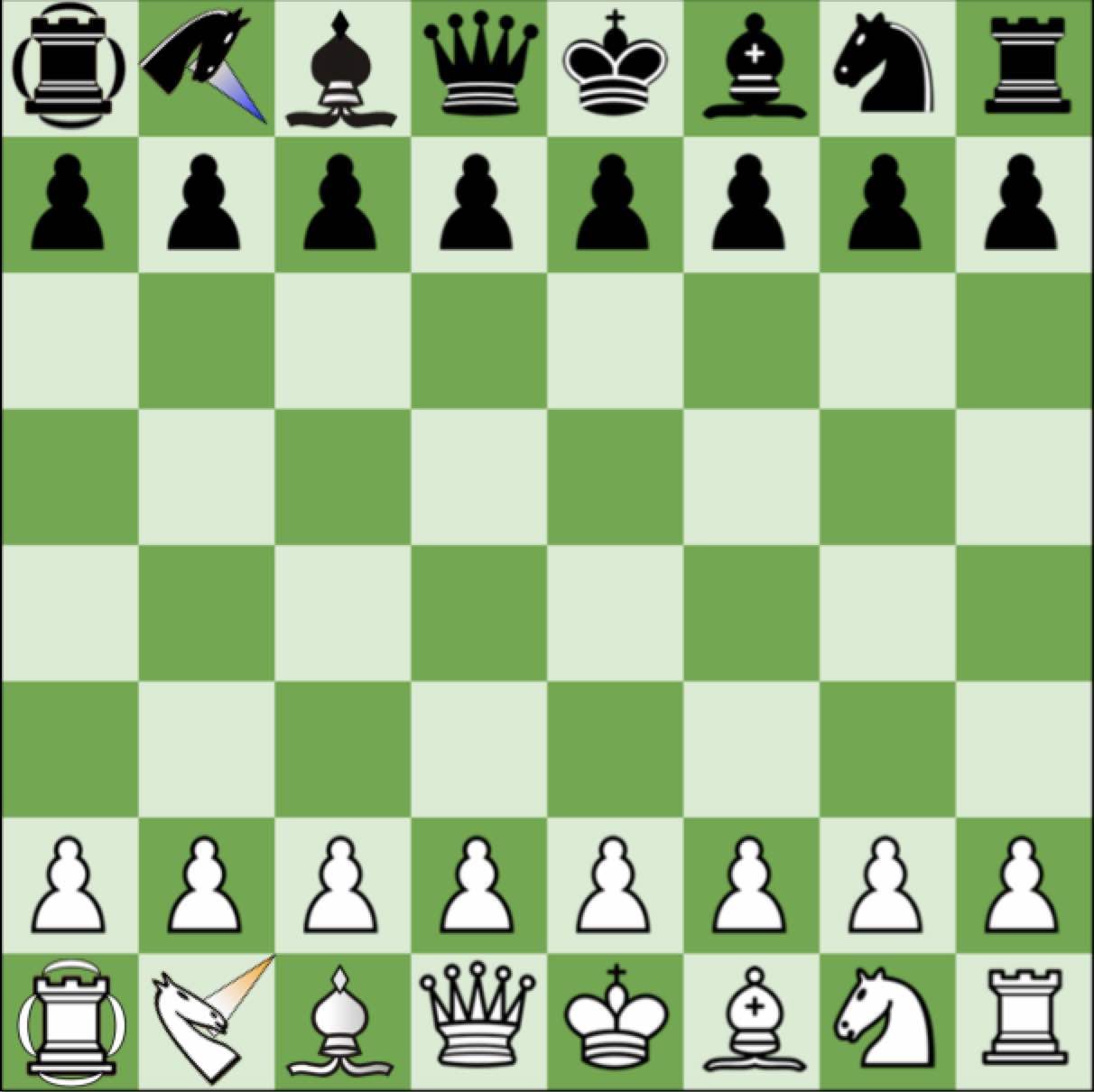
There are 8 unique pieces in the back rank:
1 King
3 minor pieces (Bishop, Knight, Sentry)
1 moderate piece (Jailer)
3 major pieces (Queen, Rook, Lancer)
Along with their own king, any single moderate to major piece can checkmate a lone king. These combinations of minor pieces, with their own king, can force a checkmate against a lone king: sentry and bishop, knight and bishop. Below, I have highlighted the new piece headings with a gray background border and wrote the rules pertaining to each. You will notice a comment in the paragraph on pawns, clarifying promotion in this game.
Note that in this description, the word "piece" does NOT refer to pawns, hence why the game is "8 Piece chess." The word "unit" = a piece OR a pawn
Pieces
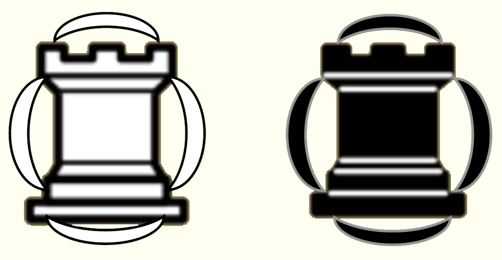
The jailer slides orthogonally like a rook, but it cannot capture. Instead it “holds” enemy units. When it is directly next to/touching an enemy unit (horizontally or vertically), that enemy unit cannot move at all, nor can it capture. It is held in place until the jailer moves away or is captured. If an enemy unit moves onto one of those 4 squares (orthogonally 1 square away from the jailer), then it is “held.” Enemy units can still move “through” the hold squares- I am only referring to when it stops next to the jailer. A jailer could potentially hold up to 4 enemy units at the same time (although not likely, as a 4th unit on the remaining hold square would have to be moved into place by the opponent) Unlike with units that capture and threaten the back rank squares, the opponent is still allowed to castle "through" a jailer's hold square i.e. if the Black jailer is on f2, White can still castle king-side (assuming all other castling conditions are met. Afterward the White rook on f1 would be "held"). However, a king and rook/jailer cannot castle if either is already held before the castle move.
Regarding the pawn's two-square movement, there is no such thing as "holding" by the jailer en passant, so i.e. a Black jailer on e3 does not prohibit a White pawn from moving from d2 to d4.
If a jailer holds the enemy jailer, then both are prohibited from moving until one of them is captured (or "pushed." Discussed in the sentry piece section). While jailers are “stuck” to each other, each jailer still exhibits hold control of the other three orthogonal squares like normal. In the spirit of encouraging a checkmate, there is an added rule to the turn-based system: when the jailer is holding the opponent's king, the opponent may “pass” as a legal move (you can only pass if the jailer is holding your king, not in any other situation). This means that a king+jailer can checkmate a lone king. In that scenario the winning King would deliver the checkmate since it can move directly next to the opponent’s king (which cannot move at all). A jailer can be part of a castle move just like the rook. The same rules and condition apply for Queen’s side (0-0-0) castling as one would need for the King's side (0-0) castling. I estimate the jailer’s value at 3.5 to 4.

Above, the bishop is not actually pinned because jailers cannot capture. It is probably best for White to move the bishop or else Je7 would hold the bishop for Black’s King to take two moves later. Bg4 looks good, as it protects the King from Je2 (holding the King). Black would probably win this game, but Bg4 puts up a good resistance.

The lancer begins the game facing diagonally inward, and it moves the same way that it captures. It moves by “jumping” straight forward - over multiple friendly units if desired - in the direction that it is facing. It can move to any available square that it is facing up to and including the first enemy unit in that direction. It cannot jump over an enemy unit or land on any square beyond that first enemy unit. The movement/capture does not have to involve jumping over a piece. After it lands on an empty square or captures a unit, as part of the same move, the player can turn the lancer to one of the other 7 primary directions – or may leave the lancer facing the same direction it just moved. A player may not turn a lancer without moving it first (with a couple exceptions). If a player moves his or her lancer onto an enemy jailer's "hold" square, then that player is still allowed to turn the lancer (finishing the move) to face the desired direction before it becomes "held" by that enemy jailer. I estimate the lancer’s value at 4.5 to 5.
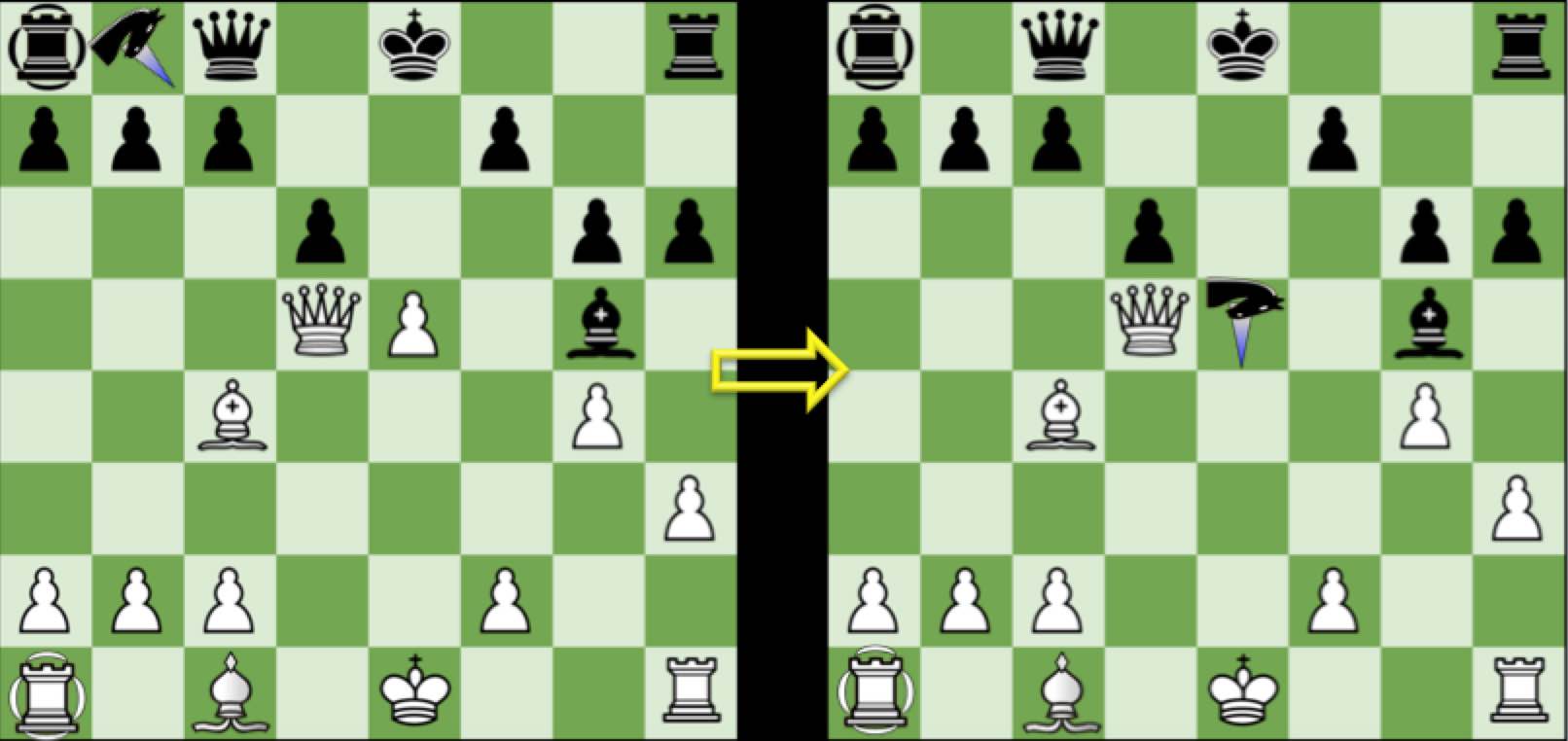
Lancers may jump over friendly units. In the above example, the Black lancer is currently facing “southeast.” It can take the pawn on e5 and then turn south, putting the White king in check. Turning toward the White king would be necessary to prevent Qxf7+.
There are two instances when a player can move his or her own lancer differently than straight forward in the direction it is pointing. These are those exceptions:
1. Re-orient: only allowed if a player's lancer is on the edge of the board and also aimed directly at that edge of the board (or corner). The player can turn the lancer away from that edge (or edges). i.e. a lancer on a5 aimed northwest can do a re-orient and when the move is complete, it remains on a5 but aiming in some other direction than the east directions (five options in this case). This is one of the times a player can turn as a move in itself. A re-orient is allowed even if the lancer is held by the enemy jailer (assuming the lancer's requirement of being on the board edge, facing that edge).
2. Turn-then-Move: please read the Sentry section to understand more about pushes. Turn-then-Move is only allowed if a player's lancer was just pushed or nudged by the enemy sentry. It involves turning to one of the 7 other directions and then moving forward (with jumping friendly units allowed, and capturing still allowed). After a Turn-then-Move, the player is not allowed to turn the lancer again to complete the move. It is the opposite order of how a lancer normally moves then turns.
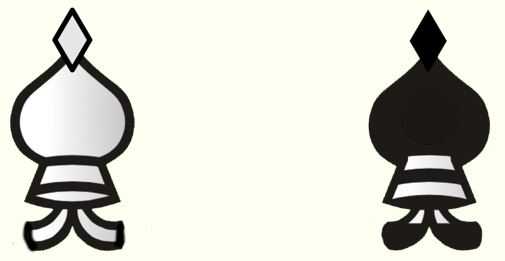
The sentry slides diagonally like a bishop, but its interaction with enemy units is called a "push" and not a capture. It slides up to an enemy unit and then occupies that square. Then the owner of the sentry, to complete the turn, moves the enemy unit according to that unit's normal movement/capture rules. The main idea is that the sentry is pushing the enemy unit away to a chosen square (chosen by that sentry-owning player), and if that particular enemy unit is a "capturing" type (pawn, knight, bishop, lancer, rook, queen, or king) it can actually be pushed to capture one of its own units. A good way to think of it is during the push, it is essentially the same color as the sentry. When it comes to rest after the push, it belongs to the opponent again. For this reason a player may not use the sentry's push abilities to capture his or her own units. I estimate the sentry's value at 2.8
As an official rule, a piece (non-pawn unit) that was just pushed by a sentry may NOT move immediately back in the direction of the sentry. The square it just got pushed from and all the squares it just got pushed through, are off-limits on the very next move. As for knights, "back in the direction of the sentry" only refers to the square it just moved off of... all squares the usual L shape away from the knight are legal to move to after being pushed, except where the enemy sentry now resides.
Above, the sentry just pushed the king into check from a2 onto a1, and since the king cannot legally move back to the sentry's square, it is checkmated.
When a sentry pushes a pawn, it acts as a pawn of the same color as the sentry. This means it temporarily moves the other direction, as if it belongs to that sentry's owner:
Above, White can take the bishop by pushing the pawn to attack diagonally. Afterward, Black is allowed to recapture the sentry with that very same pawn, because pawns are exempt from the rule by which pushed pieces cannot immediately capture the sentry.
A pawn may move either 1 or 2 squares straight forward if it is on the 1st or the 2nd rank (it does not necessarily have to be its first move. Regarding the back rank: en passant capture still applies if a pawn moves 2 squares forward from the 1st rank/back rank. A sentry can never push a pawn two squares, regardless of where the enemy pawn is.
If a sentry pushes an enemy jailer, that jailer cannot be pushed to capture any units. In the battle analogy, the idea is that the jailer is not equipped to capture anything. It also does not "hold" any friendly unit, since after the disorientation/push it becomes like a regular jailer again for the enemy (not affecting its own friendly units). Similarly, if a sentry pushes an enemy sentry, it would only be sliding it diagonally to an empty square and the enemy sentry does not push (or capture) any other units (a rule to avoid overcomplicated scenarios). A sentry pushing an enemy sentry would be rare anyway, since they occupy opposite shades of square from the opening. Such a situation could only happen if someone promoted his or her pawn to a sentry.
When a sentry pushes a lancer, the sentry's owner (i.e. Player A) has TWO basic options: to move the lancer in the direction it was facing as if the lancer belongs to him/her, OR Player A can push the lancer to any EMPTY adjacent square: called a "nudge." After the forced move/capture/nudge, Player A's turn is over. Player B then has three options immediately if he/she wants to adjust the lancer:
1. Moves the lancer in the same direction it just got pushed, and then turns the lancer (if desired) to complete the move.
2. Re-orients (also mentioned in the lancer section). ONLY IF the lancer is on the very edge of the board, facing that same edge: a re-orient spends a move to turn to a direction away from the edge (any direction with square(s) in front of the lancer). i.e. if it was pushed northeast onto g8 aiming northeast, then you can leave it on g8 and re-orient it any direction as long as it isn't still facing north/northwest/northeast. You may also re-orient later in the game, assuming the edge requirements; it would not have to be immediately after being pushed. As mentioned previously, a re-orient is still allowed if the lancer is held by the enemy jailer, at any point in the game (assuming the lancer also happens to be on the board edge, facing that edge).
3. Turn-then-Move: also described in the lancer section: you turn the lancer, then move the lancer in the new direction without turning it afterward (a reverse order of what is normally done.) If the lancer is pushed to an enemy jailer's hold square, then the lancer's Turn-then-Move option is only a turn; you can immediately turn the lancer (as your move) to any direction, but since it is "held" it cannot move after the turn.
Simply put, there is only enough time for player B to turn the lancer ONCE and also move it. Option 3 is only available immediately after the player's lancer was pushed.
Keep in mind that during the push of a lancer, the lancer should be considered the same color as the sentry. This means it can jump over units of the sentry's color:
Above, one way that White can get out of check is by pushing the lancer over the king and other White units as if the lancer is temporarily a White unit during the push. It would have to stop on the first Black unit's square, but in this case there isn't another Black unit on this bottom rank. ALSO NOTE that White could have "nudged" the lancer to g2 aiming northwest or pushed it to the empty h2 square aiming north. A sentry can nudge the lancer to any empty surrounding square (only one square away) but cannot capture in this manner. In the situation above, the lancer is not allowed to move back toward the knight because of the rule about not moving immediately back toward the sentry after a push. However, if Black does not immediately Turn-then-Move, then Black is allowed to Re-orient (at any time) with the lancer to get it "back in the game."
Sentries' cannot directly prevent the opponent from castling with its push ability alone (aiming directly at the king for example), unless its push-to-capture ability threatens one of the squares the king moves through during a castle.
A final note about sentries: they are never considered "pinned" by a piece they could capture by pushing:
Above, with Black's turn to move, the Black sentry is not completely pinned, because during Black's turn it can push the White bishop to capture the queen. Of course, any other move with the sentry would not be allowed in this position, as it leaves White free to capture the king.
Pawn 
The pawn moves differently from how it captures. Each pawn moves one square straight forward, but from the 1st rank/very back rank or the 2nd rank/starting rank, it may slide 2 squares forward if desired. It captures one square diagonally forward. If an enemy pawn makes its first move 2 squares forward, stopping next to a player’s pawn (to the right or left of it), that player has the option (only on the very next move) to capture that enemy pawn “en passant” (in passing). It captures diagonally to the square the enemy pawn just passed through, and the enemy pawn is removed from the board. When a pawn reaches the last rank, it is immediately promoted: replaced by any other piece of the player’s liking aside from a king. If a pawn promotes to a lancer, that player may turn the lancer to any main direction to complete the move. If it promotes to a jailer, then enemy pieces orthogonally 1 square next to it are held immediately. The pawn's value is about 1.
Rook 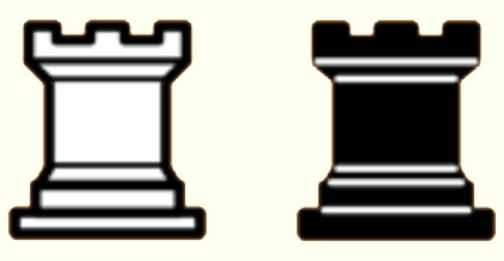
The rook slides orthogonally as many squares as one wants, assuming a friendly unit is not in the way. It can slide up to an enemy unit and capture it, then occupies the enemy unit’s former square. Its value is about 5.
Knight 
The knight is a “leaping” piece that can jump over any units, friendly or enemy. It cannot be “blocked” by any any units. The movement is to any available square that is located 2 squares in one direction orthogonally and 1 square to either side (left or right from there); it is an “L” shape. Available squares are either empty or occupied by an enemy unit, which it can capture. Its value is about 3.
Bishop 
The bishop slides diagonally as many squares as one wants, assuming a friendly unit is not in the way. It can slide up to an enemy unit and capture it, then occupies the enemy piece’s former square. Its value is about 3.2.
Queen 
The queen has movement that combines the power of rook and bishop. It can slide orthogonally or diagonally as many squares as one wants, assuming a friendly unit is not in the way. It can slide up to an enemy piece and capture it, then occupies the enemy piece’s former square. Its value is about 9.
King 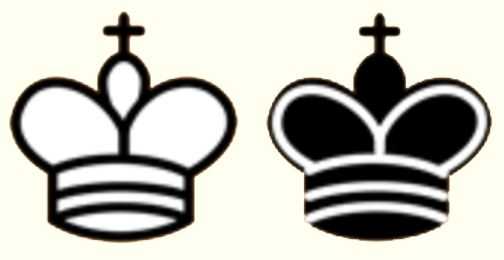
The king can move one square in any direction and captures the same way. There is one exception; it can move 2 or more squares if it is part of a “castle” (depending on whether you use the standard or randomized opening setup); Its value is “priceless” because one loses if the king is checkmated. However, many have estimated that its power is worth about 3 to 4, in terms of its influence on the game.
Rules
8-Piece Chess has the same rules and goal of standard chess, but with these additions:
- If a king is held by a jailer, then the player whose king is being held may pass as a legal move.
- A king can deliver checkmate (on a bordering square from the mated king) if the mated king is being held by his or her jailer.
- Pieces and pawns can be pushed away from their square by the enemy sentry, and if they are pushed, they may not immediately move to any square that is back in the direction of the sentry (from where that unit resides after the push) This rule that prohibits immediately moving toward the sentry does not apply to pawns; pawns can immediately capture the sentry if they were just pushed diagonally to capture something.
- Pawns may promote to any non-king piece from this game, and if it promotes to a lancer, that player may turn the lancer to any of the 8 major directions to complete the move.
- 50 Move Rule: if each player has moved 50 times in a row without either of these happening, the game is automatically drawn: 1. Any unit has been captured. 2. A pawn has moved to a new square (to a square it has never resided on so far in the game). This means if a pawn moves forward, then is pushed backward by the enemy sentry, and then moves forward again to the same square, it does not count as a "reset" of the 50 moves.
Notes
Notation for the Lancer is with an L, then x if it captures, then the coordinate of the square it lands on, followed by = and the direction it turns toward (from White’s perspective, like the directions on a compass: n, e, s, w, ne, nw, se, sw) For example: Lc2 = e (facing directly to the right from White’s perspective) Lxe4 = w (facing left from White’s perspective) If the Lancer does not change direction after a move, there is no = sign or direction mentioned. Here’s an example of that as a very first move for the White Lancer: Le4 (It is implied, without notation, that the Lancer continues facing northeast/diagonally up and to the right)Notation for the Sentry is with an S. If it pushes, you put a hyphen, then the push square, then a capital letter for the pushed unit (P for pawn) and then x if it captures and the coordinates of the capture square. For example, the notation for the 2nd diagram in the sentry section above would be: S-e7Pxf8 (meaning, Sentry pushes e7 pawn, and pawn captures bishop on f8).
Playing Over the Board
We do not yet have specific customized pieces for this variant, but any alternate pieces that are unique yet look similar to the knight, bishop, and rook should work fine. If you have pieces from an additional chess set (or alternate colors), you could use those in place of the three Queen’s side pieces and you will likely distinguish between a bishop and sentry, a rook and jailer, etc. Or, using only one chess set with standard pieces, an easy and low-cost way to mark the Queen’s side pieces is to use rubber bands (I found it straightforward to put bright green rubber bands on all the sentries, lancers, and jailers). Regarding the lancer’s direction, players can be mindful of how the green-marked lancer is facing. Still, in a blitz game it could create confusion about how the lancer is faced (if set to an in-between direction the players might argue over it). Instead, I would recommend the following, especially for rapid and blitz: In addition to the rubber bands, put bright orange tape around the top of the White lancer, and bright blue tape around the top of the Black lancer. Then, on the edge of the board, place bright orange and blue markers of some kind (I have used small plastic bright-colored containers – inexpensive – or you can use a blue and orange poker chip) The markers would be just off the playing area and would indicate which direction the lancer is facing for easy visual reference. Each time you move the lancer and adjust the direction, you move the marker to a spot just off the board that is in the direction it faces. For example, the orange marker at the very beginning of the game – which show’s the White lancer’s direction – starts the game on the imaginary “i8” square, next to the Black rook:
<img src="../membergraphics/MS8-piece-chess/Setup with inexpensive materials.jpg" style="height:240px; width:400px" />
Above: a crude but inexpensive method of setting up 8-Piece chess. You can clearly see the White lancer is on b1 and aims at the orange marker- so the h7 pawn can be captured (not wise to do that of course) The blue marker is at the imaginary “i1” square, next to the White rook.
Randomized 8-Piece Chess
This game can easily be configured to have a randomized back rank similar to Fischer Random Chess (AKA Chess960). The one important additional setup rule: the sentry must begin on one of these files: c, d, e, or f (which prevents White from checking Black or threatening a major piece on the very first move) The remaining rules are similar to Chess960: just like in Chess960 in which the king must be in-between the two rooks, in this case: the king starts anywhere in-between the rook and the jailer. The bishop and sentry must be on opposite shade of squares. Once the configuration is determined, the other player has a mirror image of it. When castling the King toward the g file, the king will always end up on g1 with the rook or jailer (whichever was closer to the h file) ending up on f1. When castling the king toward the c file, the king ends up on c1 with the rook or jailer (whichever was closer to the a file) ending up on d1. The king cannot be in check when you castle, nor can any square that the king moves through be attacked by an enemy piece. Original plans for the randomized version featured the lancer aiming in any random forward/sideways direction for the opening setup. However, this can pose a problem; there are setups in which a White lancer could easily capture an unprotected pawn if aiming a random direction before the first move.

Above: we see an example of a randomized setup (one of several) in which the White lancer can take a free pawn immediately, and then turn the lancer back toward his or her own pawn at a2 (preventing Black from also taking the free pawn). With that sort of obvious first move, these setups don’t inspire much opening variety nor are they fair. Therefore, when setting up Randomized 8-Piece Chess, the lancer should always begin the game facing straight forward:

This would guarantee that every pawn under attack by the lancer is protected, to be fair for Black. Even with this restriction on the lancer’s starting direction, 8-Piece Random Chess still has several thousand possible starting positions.
If anyone is interested in playing this variant, I can provide a link to a shared board we can use to play online. ([email protected])
Special thanks to:
Doug Kubach for play-testing and special rule suggestions
H.G. Muller for tips on notation for the lancer piece (from the Lancers Chess page)
Diagrams were created using modified graphics from musketeerchess.net as well as lichess.org.
 This 'user submitted' page is a collaboration between the posting user and the Chess Variant Pages. Registered contributors to the Chess Variant Pages have the ability to post their own works, subject to review and editing by the Chess Variant Pages Editorial Staff.
This 'user submitted' page is a collaboration between the posting user and the Chess Variant Pages. Registered contributors to the Chess Variant Pages have the ability to post their own works, subject to review and editing by the Chess Variant Pages Editorial Staff.
By JT K.
Last revised by Fergus Duniho.
Web page created: 2019-01-28. Web page last updated: 2023-02-26
